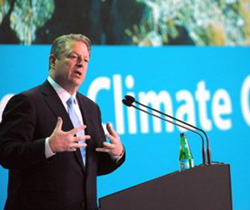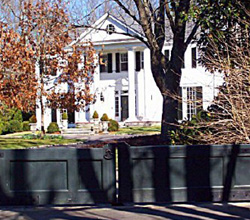Al Gore ♥ geothermal
on
Al Gore ♥ geothermal
What is the contribution geothermal energy can offer to the world’s energy production? Potentially, it is huge. Actually, the outlook is limited for the time being. But this does not deter visionaries like Al Gore who see in geothermal energy a way of saving the earth.
 |
| Al Gore at the UN Climate Conference in Poznan in December 2008 |
Gore cites the UN World Energy Assessment Report, which says that ‘the geothermal resource is roughly 280,000 times the annual consumption of primary energy in the world’. He also mentions a 2006 report by the famous Massachusetts Institute of Technology, which estimates that ‘the technically extractable portion’ of the US geothermal resource ‘is about 2,000 times the annual consumption of primary energy in the United States.’
Philippe Dumas of the European Geothermal Energy Council (EGEC) in Brussels calls this MIT report ‘the bible of the geothermal energy business’.
However, when we look at the World Energy Outlook 2008 of the International Energy Agency – what we might call ‘the bible of the energy sector’ – we read that geothermal energy made a contribution of just 0.3% to the world’s electricity production in 2007. The IEA expects that contribution to triple in absolute numbers (from 60 TWh to 180 TWh) in the coming decades, leading to a doubling of geothermal’s market share to 0.6% in 2030. In other words, according to the IEA geothermal will still be an insignificant source of energy 20 years from now, despite a tripling of geothermal energy production.
Obviously there is a large discrepancy between geothermal’s huge potential and its rather modest actual and predicted contribution (under business as usual assumptions) to the world’s energy supply. This, say the likes of Al Gore, is unfortunate because geothermal is a unique renewable energy source. It is not only clean, it also unique among renewables in that it provides alternative baseload capacity for electricity production. It is not an intermittent source like solar or wind energy. And it is also of course locally available – both in the US and Europe – indeed, virtually anywhere in the world.
Growing excitement
So why do we use so little geothermal energy at this moment? And what is needed to change this. The major reason is that the most promising technologies to deliver geothermal’s potential are still fairly new.
When we talk about geothermal energy, we should distinguish three types:
- Conventional geothermal electricity, which has been around since the beginning of the 19th century
- Enhanced geothermal systems, which represent the promise of the future
- Geothermal heating and cooling from shallow depths, often with heat pumps – the type of geothermal energy Autogrill (see the accompanying article) is using for its restaurants in Italy
Conventional geothermal electricity was first produced at the famous “hot springs” in Larderello, Italy, in 1904. The Larderello power plant today still has a capacity of 400 MW. Together with the geothermal area of Monte Amiata, Italy has 810 MW of installed capacity. Virtually all geothermal electricity produced in the world today comes from similar conventional geothermal power plants, which are driven by steam
| ‘The system is silent, eliminating the whirring noise of an outdoor air-conditioning unit in the summer’ |
However, ‘the new and growing excitement about geothermal electricity’, as Al Gore puts it, comes from ‘new technologies that make it possible to exploit sites deep in the earth that have enormous amounts of heat but lack one or more of the characteristics found in hydrothermal reservoirs. For example, many of these sites do not have water.’
These what we might call “unconventional” geothermal resources are called Enhanced Geothermal Systems (EGS) – by analogy of enhanced oil recovery (EOR).
Indeed, the promise of EGS may in theory be stupendous, it faces similar challenges to the ones enhanced oil recovery faces. First, there are the new technologies needed to exploit the huge sources of heat that exist several kilometers deep into the earth. As Al Gore describes it, ‘wells are drilled several kilometers below the surface to reach hot, often dry rock. Pressurized water is pumped down into the well, “enhancing” the site by cracking apart seams in the rock through which the added water can flow. The now-heated water is pumped back to the surface, where it is converted into steam to drive a turbine, generating electricity.’ In other words, highly complicated processes.
Another big challenge is finding the best locations – “hot rocks” at some 3 to 6 kilometers deep. This requires drilling – which is very expensive of course. A single drill hole can cost $5 million or more. Luckily for the geothermal sector, the oil and gas sector has acquired a lot of knowledge about the earth’s geology, which can be used to find geothermal sources as well.
 |
| The Gore Mansion in Nashville, Tennessee |
EGEC thinks that 4,500 MW of EGS can be achieved in Europe by 2020, and costs should be brought down from €200-300 per MWh now (€0.20-€0.30 per kWh) to a more cost-competitive figure of €70 per MWh in 2030. However, the organisation admits that a lot of work still needs to be done and the financial risks are high.
The third category of geothermal energy are the geothermal heat pumps or ground source heat pumps. They are in a category of their own. They make use of heat sources at a dozen or a few hundred meters below the surface, where temperatures are some 15 degrees Celsius. The heat pumps are used for both heating and cooling purposes.
Geothermal heat pumps represent a ‘mature market’, says Dumas. There were 721,796 heat pumps installed in the EU in 2007. Over 100,000 new heat pumps are installed each year, so there should be about 1 million installed by now. The growth rate has been steady for a number of years.
Sweden has the most heat pumps installed – some 300,000 in 2007, with some 30,000 added each year. Germany and France are in second and third place. Likely future growth markets are, among others, the UK, Italy, Spain and Portugal, says Dumas.
The Geothermal Panel of the European Technology Platform has produced a “vison paper” for 2020-2030, in which they announce that ‘geothermal heat pumps will be firmly established in the markets of all EU countries’. Heat pumps should supply between 12% and 34% of the heating and cooling market by 2030, the Panel writes. One of the main challenges is to get geothermal energy to be integrated ‘as a standard in the housing energy system’. For new buildings this is already increasingly the case in many countries, but the Panel notes that it is also important to develop geothermal solutions for existing buildings.
As to costs, the biggest problem is the capital cost, which takes time to be recouped. Thus, it takes an owner with a long-term vision to want to invest in geothermal home heating – someone, for instance, like Al Gore. ‘A few years ago’, he writes in his new book, ‘my wife and I decided to install a new geothermal heat pump system for providing heating, cooling and hot water to our house’. Gore says he is very satisfied with his purchase: ‘The system is silent, eliminating the whirring noise of an outdoor air-conditioning unit in the summer … The air in the house is comfortable: warm in the winter and crisp, cool and dehumidified in the summer.’ Not unimportantly, the geothermal pump also saves the Gore family a lot of money on their utility bills. If you have a house like a castle, these little things can make a difference.
|
A battle for the underground? The geothermal energy sector is not the only one looking at the possibilities of the underground structures of the earth. Carbon capture and storage (CCS) also requires underground spaces. In fact, says Philippe Dumas, there is a potential conflict between the two uses, as they both may target the same deep aquifers. What is more, the nuclear sector is involved in this as well, as governments are searching for suitable underground storages for nuclear waste. So will there be a battle for the underground? EER will return to this subject shortly. |


Discussion (0 comments)